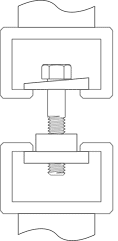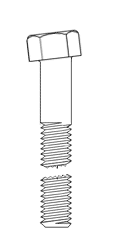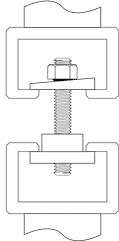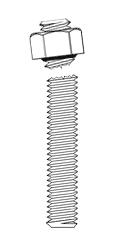When a threaded rod with a nut is substituted for a bolt with a forged head, two issues come into play. When in-house mechanical testing was performed by Portland Bolt on headed bolts versus rods with a nut, both from the identical lots of steel, the rod with a nut developed up to 12% less strength than the comparable headed bolt. The reason for this reduction in strength on the rod with nut is that the stress area at the junction of the rod and nut (which is substituting for the forged bolt head) is significantly reduced. Because the minor diameter (root) of the threads is significantly less than the full-size diameter of the unthreaded shank on a headed bolt, the rod with nut often breaks at a much lower strength than a headed bolt. More importantly, even if the rod with nut does develop enough strength to meet the specification, it will often break at the junction of the nut which is acting as the head of the bolt when wedge tested per ASTM F606. For this reason, technically a rod with a nut in lieu of a headed bolt will frequently fail mechanical testing because the head (nut in this case) comes off before the bolt breaks in the body or threaded section of the fastener which constitutes an automatic failure.
We often see fastener distributors and manufacturers without forging capabilities talking customers into switching from a headed bolt to a rod with a nut since they are unable to provide the forged product that was engineered into the structure. We see this most frequently with regard to headed anchor bolts. Making the decision to switch from a bolt with a forged head to a rod with a nut should always be approved the Engineer of Record to prevent any liability in making such a substitution should a failure of the fasteners occur.
Wedge Testing per ASTM F606




Note: Wedge testing as shown above is required to obtain mechanical properties for most ASTM high strength fasteners. A greater difference was found for high-strength fasteners than mild steel fasteners during Portland Bolt in-house testing of headed bolts versus rods with a nut. The reduced cross-sectional area at the junction of the nut as compared to a bolt with a forged head caused the fasteners with a nut acting as a bolt head to break at lower strengths than the bolts with forged heads. Additionally, the high strength rods with a nut acting as a head broke just below the nut which would automatically constitute a failure since the wedge test requires the bolt to break either in the body of the bolt or in the threaded portion, not at the junction of the head.
How much can a grade 8 all thread. Take before it pulled in half
@Jessie – Grade 8 all thread, or any grade 8 fastener will have a minimum tensile strength of 150,000psi. To calculate the specific tensile strength of your size of all thread rod, you will need to multiply 150,000 by the tensile stress area of your diameter. Those values can be found on our website in the Technical Information area under Thread Pitch Chart.
It is my understanding, while very rare and probably custom, that an upset rod would yield similar results to the headed anchor. Correct?
@Ryan – It might, it would largely depend on the application and dimensions of the upset rod/bolts in question.
John, a smooth-sided anchor BOLT embedded in concrete works differently to an embedded rebar. It is preferable to use a BOLT since the head ‘grabs’ the concrete deep within, rather than spreading the bond along its length. Failure of the concrete in this case is closer to the surface, which is undesirable. Also, the smooth side of the bolt allows it to ‘stretch’ all the way down to the head, and thus be correctly torqued.
This test is all well and good, but when a threaded rod is embedded in concrete, I would think it would more securely “bond” with the concrete along the length of the threads and distribute the tensile load better than a headed anchor bolt with a smooth shaft, which would only resist forces at the head. But this is just my intuitive thoughts of the situation — maybe someone can comment and let me know for sure. I know that is at least how rebar works though.
@John – The concern here is in substituting one for the other. When a rod with nut is substituted for a headed bolt, the concern is that the rod/nut may not perform as well as the headed bolt. At the junction of the nut with threads, the minor diameter is smaller than at the junction of the forged head/shank. When these two combinations are tested in a lab, the forged head is far superior to the rod/nut. A fastener will always fail at it’s weakest point, by substituting the rod/nut for a headed bolt, you are possibly moving that point from the threads on the top to the junction on the bottom. That may create problems and is a decision that an engineer should make.
Will it help if the junction of the nut and the rod be tack welded. It might compensate for the 12% reduction in strength.
@Rodel Minlay – Tack welding shouldn’t make a difference in this case. In fact, most of the rods with nuts that are substituted for headed bolts are tack-welded by default. The real reduction in ultimate tensile strength in a rod with a nut stems from the fact that the tensile stress area on the threaded portion of the rod is the minor diameter of the thread, whereas the tensile stress area of a headed bolt is the full shank diameter.